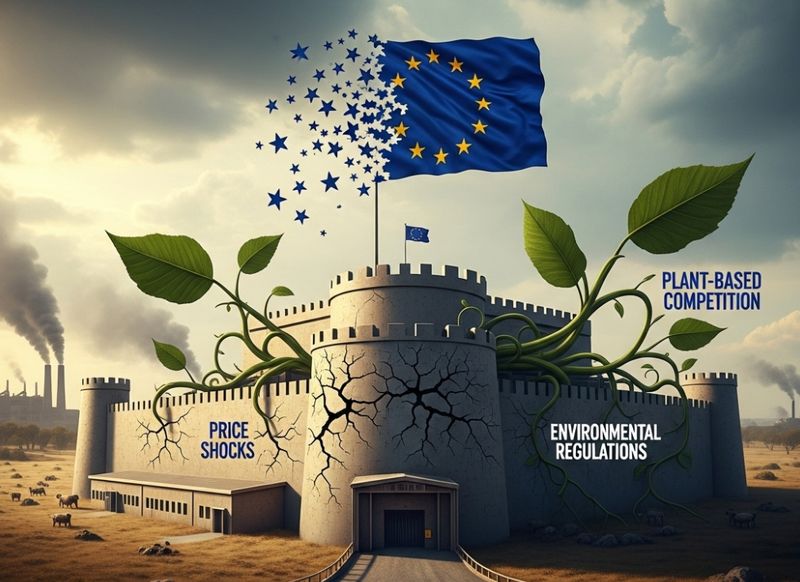
Price Shocks, Plant‑Based Naming Fights & Deforestation Rules: What EU Meat Producers Need to Know (28 July 2025)
Global factors are driving up beef prices, regulators are re‑writing labelling rules and new deforestation laws loom. Here’s what this means for your farm or business.
Global beef prices are soaring
A perfect storm of smaller cattle herds and robust demand is pushing prices to record levels. In the US, persistent drought, plant closures and shifting consumer preferences have reduced cattle slaughter compared with the same time last year. EU animal‑welfare rules and disease outbreaks, coupled with lower calving rates in the UK, have also constrained output. Meanwhile, consumers still want beef and are willing to pay for it.
Exporters such as Brazil and Australia have stepped into the gap; Brazil’s beef export turnover has risen sharply thanks to a jump in volumes and higher free‑on‑board prices. Importing regions like China and the EU will have to pay more. Smaller processors without leverage to switch suppliers or hedge costs are most exposed.
Implication: Farmers should expect high cattle prices to persist while herds rebuild, and processors need to plan for tighter margins. Larger buyers may secure forward contracts; smaller ones may have to explore alternative sources or adjust product mix.
EU market outlook: tight beef supply, stable pigs and more poultry
The European Commission’s latest short‑term outlook emphasises that beef prices in the EU remain historically high. Smaller herds mean beef production is set to decline, tightening supply and likely boosting imports. By contrast, pigmeat output is projected to stay stable and poultry production could rise as demand grows. Sheep and goat meat production is expected to fall, leading to higher prices and increased imports.
Implication: With beef supply constrained, processors and wholesalers should monitor import opportunities and price spreads. Pig and poultry producers can capitalise on steady demand, while lamb and goat farmers may see stronger prices but tighter supply.
Plant‑based naming fight resurfaces
The European Commission is reviving an old debate: should plant‑based products use meat terms? A proposal would ban dozens of “meaty” terms such as “bacon,” “beef” and “drumstick” while allowing “burger,” “sausage” and “steak”. Proponents say the ban will prevent consumer confusion, but critics argue that shoppers generally know the difference and that accidental purchases are rare.
Clear labelling is critical for allergy sufferers; a vegan product accidentally bought instead of beef could be life‑threatening. Yet plant‑based meat is currently only nibbling at conventional meat’s market share, and some of the world’s largest meat companies own plant‑based brands.
Implication: For processors and wholesalers, this debate is more about marketing than immediate competition. Keep an eye on labelling rules to ensure compliance and avoid mis‑selling. Highlighting “real meat” origins may help differentiate products.
Deforestation rules demand traceability
The EU Deforestation Regulation (EUDR) comes into force for large companies at the end of December 2025. A recent analysis found that only a minority of upstream and downstream suppliers have systems in place to trace deforestation risks. Under EUDR, commodities like cattle and soy must be traceable, deforestation‑free and produced legally; non‑compliance could lead to trade bans or criminal penalties. Goods must remain segregated by origin—mixing compliant and non‑compliant commodities means the whole shipment is rejected.
Smallholder farms and processors face particular challenges keeping lots separated. Excluding smallholders may simplify compliance but risks marginalising farmers.
Implication: Farmers exporting to the EU must collect geolocation data and document compliance now. Processors and wholesalers should audit supply chains, invest in traceability and help suppliers implement segregation protocols. Non‑compliant shipments could be blocked at EU borders in 2026.
Scotland warns of red‑meat supply gaps
The Scottish Association of Meat Wholesalers warns that declining breeding‑cattle numbers may lead to supply gaps in UK supermarket meat counters in 2025. Some processors already operate at reduced throughput, driving up unit costs and threatening the viability of processing lines. The association urges government action to rebuild herds and calls for clarity in policy signals.
Rising inspection charges from Food Standards Scotland — after a significant increase last year with another hike expected — compound cost pressures. Industry leaders advocate modernising inspection, possibly using technologies such as CCTV.
Implication: UK processors and wholesalers should prepare for potential supply tightness and higher regulatory costs. Engage with industry bodies to support modernised inspections and more flexible rules. Farmers may need incentives or policy support to expand herds.
By staying informed about policy changes, disease outbreaks and global market shifts, Meat Borsa members can make better buying and selling decisions. We’ll keep you updated every morning.
Sources
FoodNavigator article on global beef prices and market effects (24 July 2025).
European Commission short‑term outlook on EU agricultural markets (28 July 2025).
FoodNavigator opinion on plant‑based naming (22 July 2025).
AgTech Navigator piece on readiness for the EU Deforestation Regulation (22 July 2025).
Meat Management report on potential red‑meat supply gaps in 2025 (6 January 2025).
